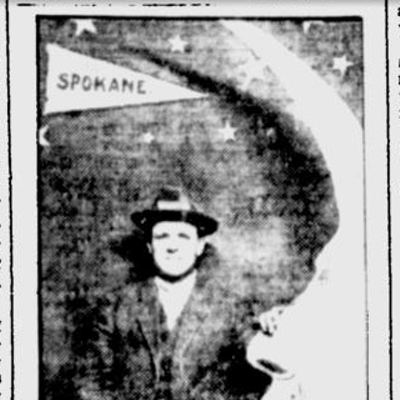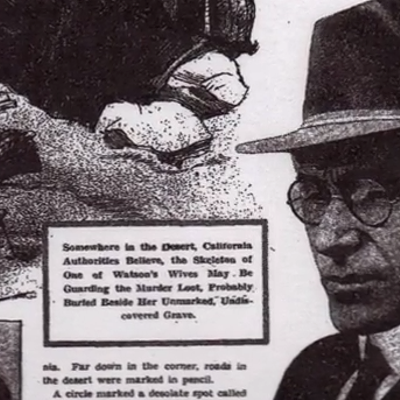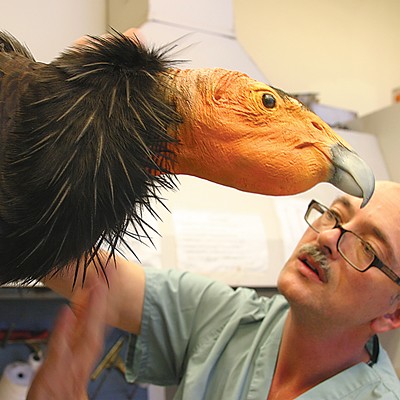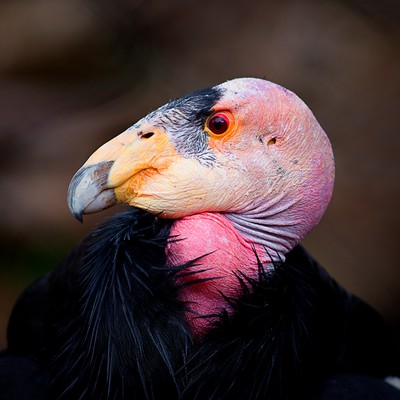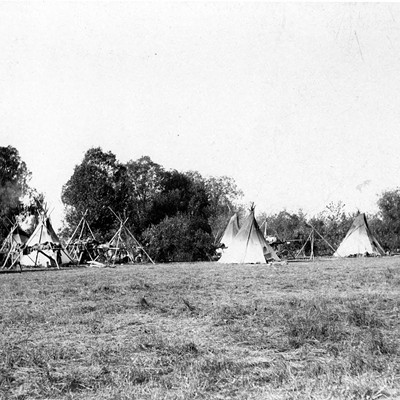Anyone who looks at rocks in the Columbia Basin south of the Spokane River sees mostly basalt — volcanic magma cooled into a delightful variety of layers, flutes and swirls. Students hear stories of magma bubbling up from cracks in the Snake River country to flow elastically north and blanket the entire region; of layers thousands of feet thick; of Lake Missoula floods crashing down from the northeast to carve the world we see now around Spokane and in the Cheney-Palouse scablands. Teachers place the basalt flows in the Miocene Period, from 17 million to 7 million years before the present. They crack open cakes of clay that built up between eruptions and show off imprints of leaves and needles from familiar trees as proof that a long time ago this was a wet, warm place.
But what lies beneath all those layers of basalt? Steptoes of very old rock in the Palouse hint at limitless possibilities. In the early part of the 20th century, oil wildcatters wondered if black gold might be one of them, and drilled test holes throughout the Columbia Basin. Some years ago, Department of Natural Resources geologist Bob Derkey ran across a 1919 drill log from lower Latah Creek that had broken through the basalt and recorded "shells, fossils" in the middle of the usual notations of clays and gravel. The usual Latah clays yield fossil plants from fresh water environments of the Miocene Period; "shells" hinted at the remains of animals from an ancient saltwater sea, and at dates far earlier than that.
On a spring afternoon in April 2002, Derkey and DNR colleague Mike Hamilton decided to investigate a wrinkle in the landscape near Clear Lake, just off Interstate 90 in western Spokane county. Derkey, in the midst of reworking the geologic map of the county, was interested an outcrop of old limestone in the vicinity, but upon their arrival both geologists were struck by a scattering of peculiar red shale visible along the roadside and around some telephone poles. Hamilton, who grew up in the Midwest and was used to associating such shale with fossils, sat down among the red chunks and began to whack at their laminations with his rock hammer. It wasn't long before he found himself staring at the tail of a trilobite, one of the most ancient and revealing fossil types. Both geologists knew of trilobite sites to the north, but there were no records of such ancient fossils within several dozen miles of Spokane County.
Hamilton and Derkey took samples of the mudstone back to Eastern Washington University and showed them to Linda McCollum in the geology department. McCollum happens to specialize in trilobites, and for years has taken thousand-mile trips to southern Nevada to study a range of trilobites in very old formations of Great Basin bedrock. She is especially interested in a fossil called Glossopleura — a relatively large, distinctive and common trilobite whose life span can be used to determine the boundary between epochs in different strata of Great Basin rocks. When McCollum recognized a Glossopleura trilobite peering at her, from a rock collected just a few miles from her classroom in Cheney, it was clear proof that the reddish shale had been formed in a marine environment during what geologists the Middle Cambrian Period, more than 500 million years ago.
The geologists had to find out exactly where this red shale came from. The rise where they found the scattered chunks was part of a Fairchild Air Force Base recreational site at Clear Lake, so McCollum and her husband Mike applied for a permit to make further investigations. They found no exposed outcrops of the shale because the rock is so soft that if it does reach the surface, its layers soon weather away into mud. What the McCollums did discover was that workers on a sewage containment system had dug a series of holes on the south end of the lake, then dumped that material along the roadside on the rise.
The geologists took a small backhoe to the lakeside site and tried to dig down to the hidden steptoes, but a few trial attempts made it clear that major excavation would be necessary to expose any significant outcrops. Undaunted, the McCollums and a small group of EWU students patiently gathered promising chunks of shale from around telephone poles, rodent burrows, and a single hand-dug pit. Last summer, during further explorations in the same vicinity, the team found some more trilobites in another shale layer exposed by a drainage ditch, dug in 1904 and still in practical use, that ran through a nearby crop field.
Laboratory study of the various shale samples revealed at least four species of trilobites, including Glossopleura. The geologists also discovered tiny sponge spicules and a range of small brachiopod fossils — phosphate-based shells related to modern lamp shells. These brachiopods lived as filter feeders that burrowed in the mud or attached to stationary objects in a shallow sea during the middle Cambrian Period, when the edge of our continent ended around the border of the Idaho panhandle.
Another group of marine animals called hyolithids left their impressions behind in the shale. Each hyolithid lived inside a cone-shaped shell topped with an operculum, or door, that could close them in for protection like a modern snail. The imprint looks exactly like a small ice cream cone. Hyolithids were also filter feeders; a pair of curious tentacle-like filaments may have acted as stabilizers or oars to give them some range of mobility.
Animals such as trilobites and hyolithids, which have no direct modern descendants, add to the lure of the Cambrian Period. More than half a billion years ago, the Cambrian marked the beginning of life as we know it, with ocean ancestors of every living form except flowering plants appearing in remarkable profusion. Many are elegantly preserved as fossils, and some of the best-known examples — such as the confounding hyolithids — have been described from the Burgess Shale formation in the Canadian Rockies, 300 miles or so north of Clear Lake. Thanks to a curious oil driller, early ditch diggers, a septic holding system, busy gophers and some alert geologists, Spokane County has its own examples of these creatures to ponder, too.
Publication date: 2/10/05



